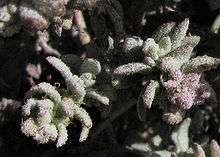Atripliceae
| Atripliceae | |
|---|---|
 | |
| Extriplex californica | |
| Scientific classification | |
| Kingdom: | Plantae |
| (unranked): | Angiosperms |
| (unranked): | Eudicots |
| (unranked): | Core eudicots |
| Order: | Caryophyllales |
| Family: | Amaranthaceae |
| Subfamily: | Chenopodioideae |
| Tribe: | Atripliceae |
| Genera | |
| |
Atripliceae are a tribe of the subfamily Chenopodioideae belonging to the plant family Amaranthaceae. Atriplex is the largest genus of the family. Species of Atripiceae are ecologically important in steppe and semi-desert climates.[1]
Distribution
Most of the species are distributed in Africa, Australia, and North America, with some others spread out worldwide.[2]
Taxonomy
Traditional taxonomy of Atripliceae based on morphological features has been controversial.[1][2] Molecular studies have found that many genera are not true clades. One such study found that Atripliceae could be divided into two main clades, Archiatriplex, with a few, scattered species, and the larger Atriaplex clade, which is highly diverse and found around the world.[2]
References
- 1 2 "Molecular phylogeny of Atripliceae (Chenopodioideae, Chenopodiaceae): Implications for systematics, biogeography, flower and fruit evolution, and the origin of C4 photosynthesis.". www.pubfacts.com. Retrieved 2015-12-30.
- 1 2 3 Flores, Hilda; Davis, Jerrold I. "A Cladistic Analysis of Atripliceae (Chenopodiaceae) Based on Morphological Data". Journal of the Torrey Botanical Society. 128 (3). doi:10.2307/3088719.
| Wikispecies has information related to: Atripliceae |
This article is issued from Wikipedia - version of the 11/14/2016. The text is available under the Creative Commons Attribution/Share Alike but additional terms may apply for the media files.